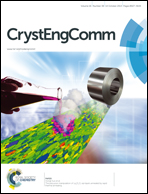Flux growth and effect of cobalt doping on dielectric, conductivity and relaxation behaviour of 0.91Pb[Zn1/3Nb2/3]O3–0.09PbTiO3 crystals
Abstract
Crystals of 1 mol% cobalt-doped Pb(Zn1/3Nb2/3)O3–0.09PbTiO3 (PZNCT) have been grown using a high-temperature self-flux method. A pure perovskite phase with mixed symmetry at room temperature was observed using X-ray diffraction analysis. Their electrical properties were further investigated by measuring temperature- and frequency-dependent dielectric constant (ε) and loss (tan δ) behaviour of as-grown crystals. To study the degree of dielectric relaxation, modified power law fitting and Lorentz-type quadratic fitting were performed. The as-grown PZNCT crystals showed a low Curie temperature (Tc ~131 °C) with a rhombohedral–tetragonal phase transition temperature (Trt) of 104 °C. The piezoelectric coefficient (d33) value at the optimized poling field was found to be ~1000 pC N−1. Complete electrical characterization revealed the growth of high-performance PZNCT crystals with enhanced remnant polarization (34.23 μC cm−2) and low coercive field (6.97 kV cm−1) with cobalt doping. The conduction and relaxation mechanisms of grown PZNCT crystals have been discussed in detail.
![Graphical abstract: Flux growth and effect of cobalt doping on dielectric, conductivity and relaxation behaviour of 0.91Pb[Zn1/3Nb2/3]O3–0.09PbTiO3 crystals](/en/Image/Get?imageInfo.ImageType=GA&imageInfo.ImageIdentifier.ManuscriptID=C4CE01105H&imageInfo.ImageIdentifier.Year=2014)


 Please wait while we load your content...
Please wait while we load your content...